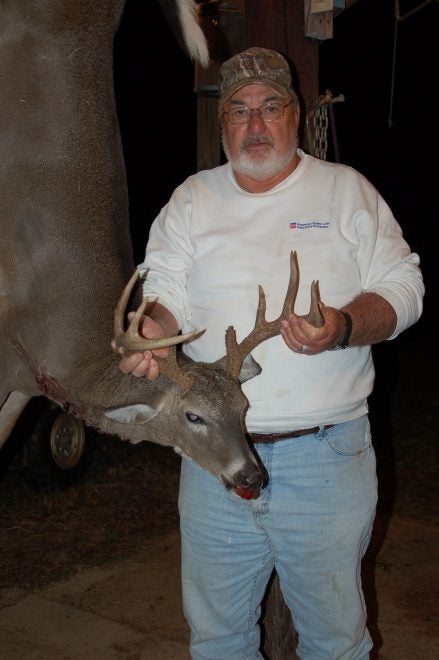Overzealous Bullet Performance
Dr. John Woods 09.07.16

Sometimes bullet performance of certain loads used on certain game animals can exceed expectations. How can that be? Some cartridge/calibers are simply doing what they were designed to do, but maybe some go beyond the minimum requirements to harvest a white-tailed buck.
Case in point is the use of the 7mm Remington Magnum and some high performance factory ammo on thin skinned animals like the whitetail deer. “John, I was told recently by a hunting friend of mine not to use those Nosler Ballistic Tip loads in Federal Premium ammo, because their performance on deer was so bad,” stated Darryl who was hunting in our camp one weekend. My response was a simple “ridiculous.”
When I asked what caliber he was shooting, he told me it was the 7-Mag. I had a slight grin on my face because I have been right where he is. I put a perfect shot on a buck several years go with a 7-Mag only to watch the deer run off at full speed. Two hours later we found the deer piled up in the bottom of a ditch. The entry wound was a tiny hole, and the exit wound was not much bigger.
The blood trail was minimal simply because at that short range under 100 yards, that ballistic tip bullet just sailed through that buck clean as a whistle. It did not hit any bones or break down structure in the buck, but blew the heart into shreds. Deer being as tenacious as they are, that buck just ran on pure adrenaline but died quickly.
Now, I am not saying that the Federal load I was using or the one Darryl was using is poor ammunition, quite the opposite. I do suggest the 7-Mag is possibly an excessive approach for typical whitetail deer hunting. The exception would be very long range shots as promoted by the interest several years ago in “soybean field deer rifles,” meaning shooting across huge agricultural fields. For that, the 7-Mag or even the 300 Mag may be a good bet.
Ballistics Matter
Let’s examine that Federal Nosler 7-Mag factory loading for its paper ballistics. If we use the load Darryl picked, it was a 150 grain Nosler Ballistic tip load. The muzzle velocity of that load stated from the Federal factory catalog is 3110 fps with a muzzle energy of 3220 food pounds. That is one hummer of a load.
For comparison if we picked a more basic Federal soft point load in a .270 Winchester, the muzzle velocity is listed at 2850 feet per second with a muzzle energy of 2705 foot pounds. Up against the 7-Mag load, the .270 is producing 500 foot pounds of bullet energy less than the magnum load. One would expect the slower, less terminal energy bullet to expand better inside a deer than the faster, more powerful 7-Mag load, all else being equal.
Now, to be fair, the factory description of the Nosler Ballistic Tip bullet is said to have low to moderate penetration, fast expansion, low to moderate bullet weight retention, and is suggested for extra-long range shooting. I think this would be true to form, if and only if that bullet struck a highly resistant body structure such as a shoulder or game with a thicker cross section than the typical white-tailed deer.
Now having said all that and having explained as much to Darryl, I just suggested that he was probably over-gunned for Mississippi whitetails with that high-powered load. Maybe if he just backed off to a pointed soft point bullet load he would get the performance he has in his mind he should be getting.
Then came his hunting and bullet performance proof. During the hunt Darryl harvested two does, one probably weighing close to 150 pounds. One of the hunting club members dropped and broke the skinning rack scale and has failed to replace it, so we are left to educated guesses on deer weights. This was a huge doe for our area based on past harvests.
At the shot, the doe ran off and was not immediately recovered. Later at the skinning rack, Darryl was again dogging out the Federal load because the doe did not simply drop in its tracks. That is until I told him to examine the entry and exit wounds. The bullet entry was no bigger than a pencil. The small opposite side exit site could be covered with a quarter. I’ve been there, seen that myself.
Ironically the second doe (much smaller at about 100 pounds) was hammered at the shot. Upon skinning the deer, the shoulder was completely destroyed, actually ruining all the meat on that side. The bullet hit the shoulder bone and shattered it and never exited the deer. The doe fell dead at the shot. My explanation to Darryl was completely substantiated.
If the Nosler Ballistic Tip bullet strikes heavy body tissue, including bone, then it is going to expand nicely, maybe too much on a white-tailed deer because of the power of the 7-Mag load. If, however, the bullet does not hit bone but only soft tissue or body organs, then there is not enough resistance to fully expand the bullet, thus it flies right on through the deer. The two does Darryl shot illustrated both issues cleanly at the skinning rack.
So, maybe the 7-Mag is just too much gun for thin-skinned deer, but it could also just be an issue of bullet placement. The Nosler bullet did what it was designed to do. The lesson here is that IF you want potential full bullet expansion on a deer, then chose a soft pointed bullet of a modest bullet weight better suited to hunting deer, not bigger game.